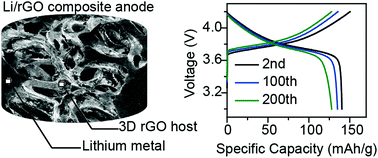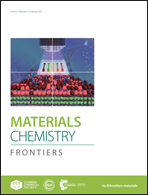3D hollow reduced graphene oxide foam as a stable host for high-capacity lithium metal anodes†
Abstract
Lithium is considered to be a promising anode material for high-energy batteries on account of its high capacity and low potential. However, both dendritic lithium formation and very large volume changes during cycling severely restrict its practical applications. Herein, we propose a 3D hollow reduced graphene oxide foam as a host for prestoring lithium. Aside from the advantages of accommodating volume change and lowering the local current density, this unique structure also provides a large host space, one that enables lithium prestorage both outside and inside the reduced graphene oxide, in which Li occupies ∼85 weight percent of the whole composite electrode. The anode showed a corresponding gravimetric specific capacity as high as 3280 mA h g−1. Moreover, it showed highly stable cycling with small hysteresis at 1 mA cm−2 in the carbonate electrolyte. When it was assembled into a full cell with NCM (Li(Ni1/3Co1/3Mn1/3)O2) as the cathode, the resulting battery showed good cycling performance, having displayed 92% capacity retention (128.2 mA h g−1) and appealing power capacity (82 mA h g−1 at 5C) after being cycled 200 times at 0.3C.

- This article is part of the themed collections: 2019 Materials Chemistry Frontiers HOT articles and Graphene-based architectures for energy storage


 Please wait while we load your content...
Please wait while we load your content...